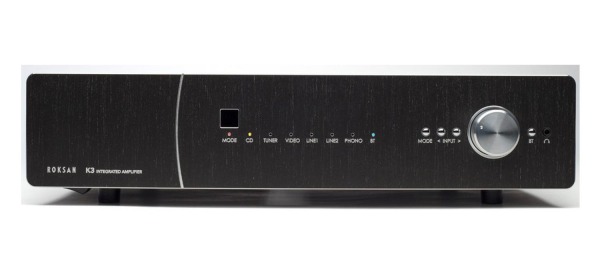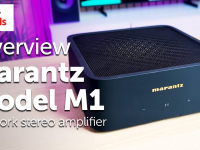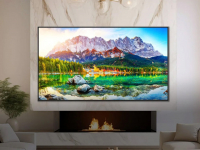 Following up an award winning product mustn’t be easy. Stick with too much of the original design and you risk falling behind in the technology stakes. Too little and you’ve got the potential to lose what made the product so good in the first place. Finding that middle ground can prove tricky, and some fall at the first hurdle. Still, it’s definitely not the worst position to be in. Roksan, the London based HiFi designers, fill this roll today with their latest offering: the K3 amplifier.
Following up an award winning product mustn’t be easy. Stick with too much of the original design and you risk falling behind in the technology stakes. Too little and you’ve got the potential to lose what made the product so good in the first place. Finding that middle ground can prove tricky, and some fall at the first hurdle. Still, it’s definitely not the worst position to be in. Roksan, the London based HiFi designers, fill this roll today with their latest offering: the K3 amplifier.
Its predecessor, the K2, was extremely well received upon its original release, bringing solid build quality, good looks and a brilliant, powerful sound. The K3 looks ready to step into its older siblings shoes – and to fill them comfortably.
Unboxing the K3 immediately points to one area that hasn’t changed. The enormous toroidal transformer from its predecessor is seen again here. Literally one half of the case is given over to this beast, and it’s capable of throwing out almost 220 watts into a 4 ohm load. It certainly adds a huge amount to the weight, coming in at a chunky 14kg.
The front fascia has seen a few changes, with most of my colleagues agreeing they’re for the better. The K2 was a great design for the most part, but its very stodgy volume dial was a bit of a pain to grab properly. It’s a problem that’s been rectified here; the new volume dial is much easier to handle, protruding to a much more sensible length. Other than that, we’ve got a smart, clean layout. The fascia is a slab of brushed, black-coated aluminium. The seven inputs are switched via two buttons by the volume dial, with the exception of Bluetooth that has its own button to activate the receiver inside. Speaking of Bluetooth, it’s the second Roksan to come with it as a built in feature, and it’s definitely nice to have it on board. Using the more up to date Apt-X technology brings this otherwise relatively low quality connection up to a better level. A moving magnet phono stage is also included, with the other five inputs being standard line in. Around the back, one pair of speaker terminals are present, so bi-wiring isn’t an option. This is not a great loss in my opinion, with an integrated amplifier not showing huge benefits when wired this way. Pre-outs are also fitted for use with a subwoofer or an AV receiver.
Partnered with the Dali Ikon 6 MK II, the amp was given the customary running in session before any critical listening.
Given its huge increase in popularity (vinyl sales are their highest since 1996 this year), the first batch of tracks I listened to were played from the truly superb Project ‘2 Xperience 2 Pack‘. This is one of the nicest, well designed bits of kit I’ve ever played about with, and even a die hard digital enthusiast like myself is totally smitten with the sounds it makes.
My personal album of the year, Aphex Twin’s Syro, is a great test of dynamics, timing, pace and lots of other important Hi Fi points. The vinyl version, running into the Roksan sounded fantastic. It’s a brilliantly produced album anyway, but on the Roksan it sounded so clean and detailed, and really eked out every last sound down in the grooves. The ten minutes of second track XMAS_EVET10 is a constantly evolving tapestry of analogue sounds and programmed beats. The Roksan’s minimal noise floor, courtesy of the huge power supply, gave great insight, but delivered an organic sound, rather than showing any digital hardness. As the album played on, this was true of all of the tracks. Clarity and power, but with tremendous ease.
It’d be remiss of me not to use the Bluetooth given its inclusion. Switching things up a little bit, I loaded up the TuneIn app on my phone and streamed Internet radio rather than music from my own library. Shop favourite SOMA FM: Groove Salad is a wonderful, advert-free mix of downbeat grooves. It streams at a decent bit rate, and certainly isn’t low quality, but it’d be a test nonetheless.
Half an hour later I was still hugely impressed! The same result: clarity, detail and a great soundstage, but no real digital harshness. The extra power had the Dali’s firmly in their comfort zone regardless of volume. The two were a brilliant match up, but I think the neutrality of the K3 would see it work well with almost any potential suitor. A few less well recorded albums fell foul to this warts-and-all presentation at times, but they did on other amplifiers too. If the source material is poor, it’s unfair to blame the system.
Overall, I felt the K3 was an exceptional performer. It’s not an overly romantic amplifier, it’s not got the warmth of certain brands, but it isn’t hugely clinical. I like to hear the work that’s gone into a song and if it’s not great, fine, let me hear it. The Roksan achieved this whilst not coming across as bright or strident.
Who says sequels always end up worse than the original? Not this time around at least. Well done Roksan.
Roksan also do the accompanying CD player, the Roksan K3 CD.
Contact your local Richer Sounds store to arrange a demo of anything you like the look of!
Author: Chris, Liverpool store







